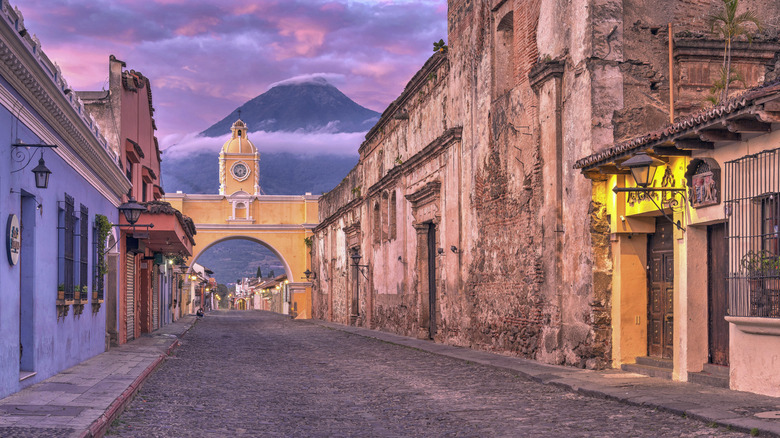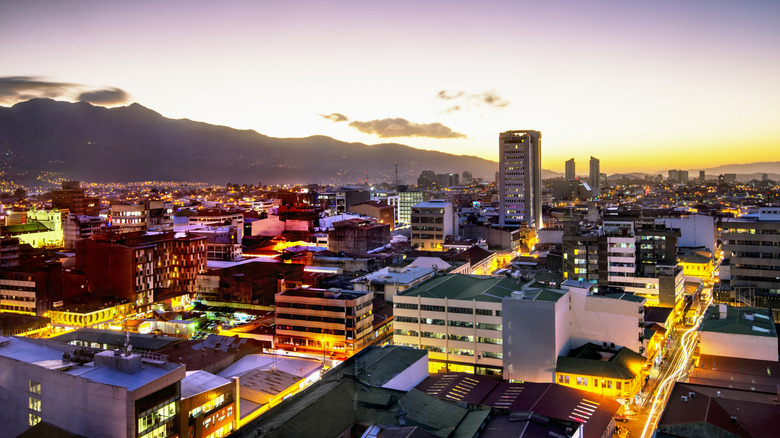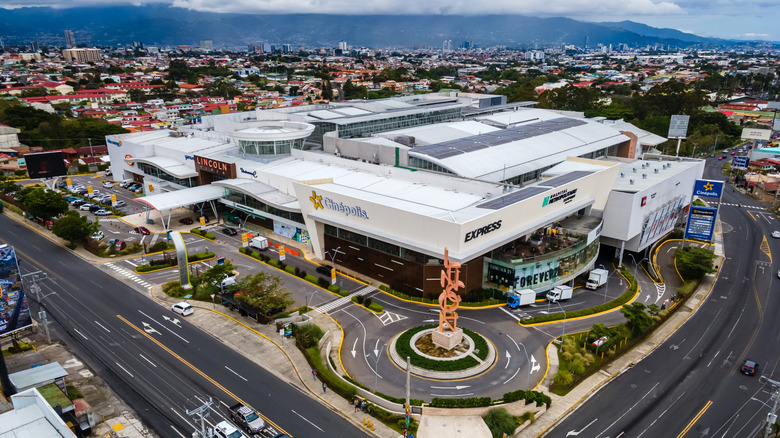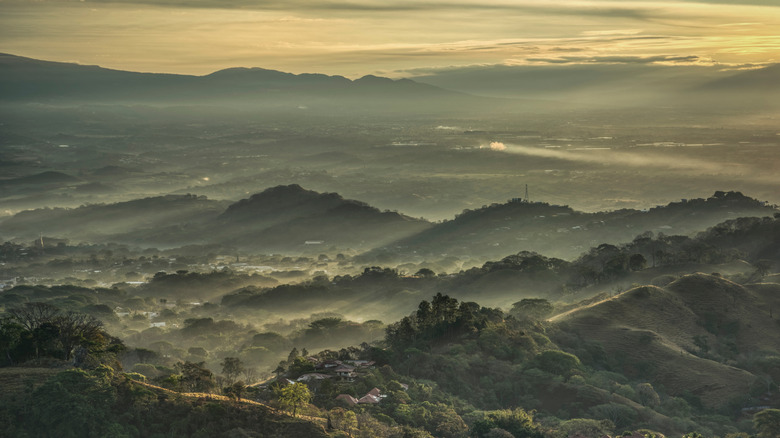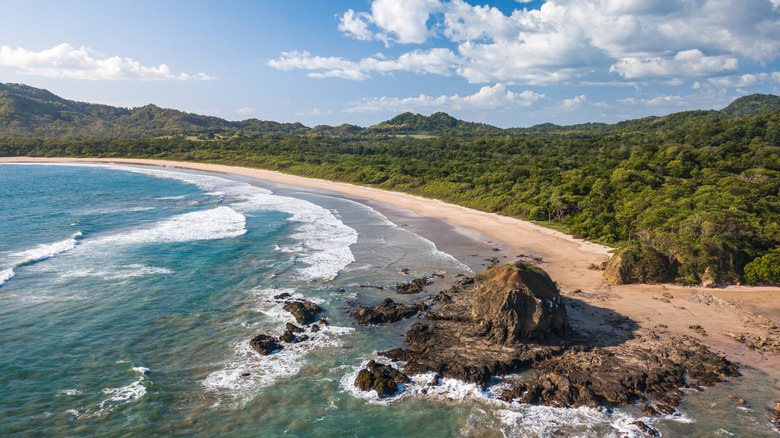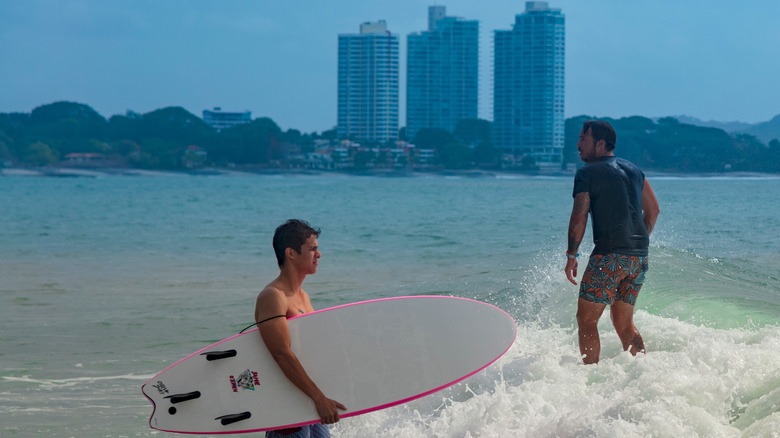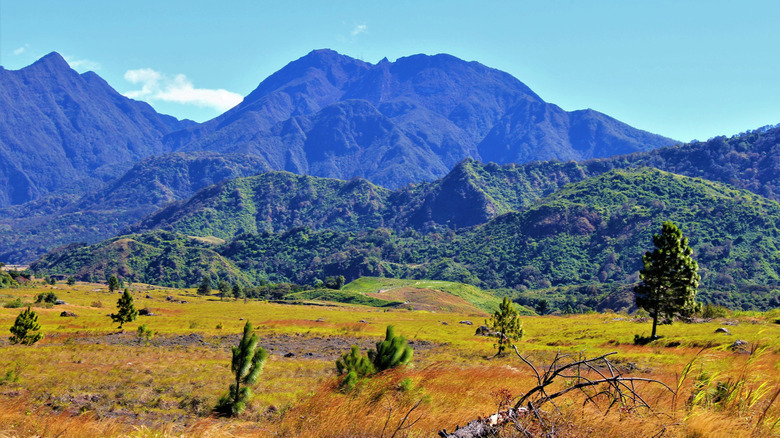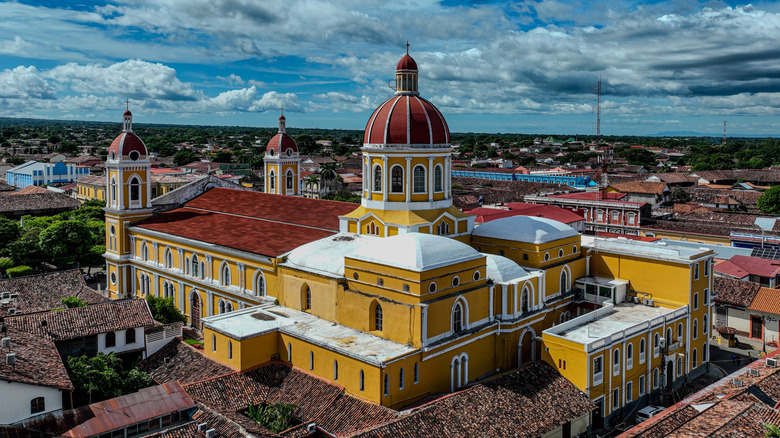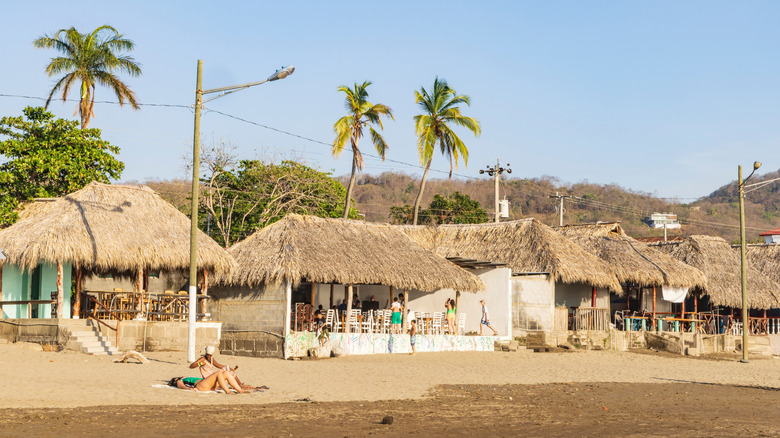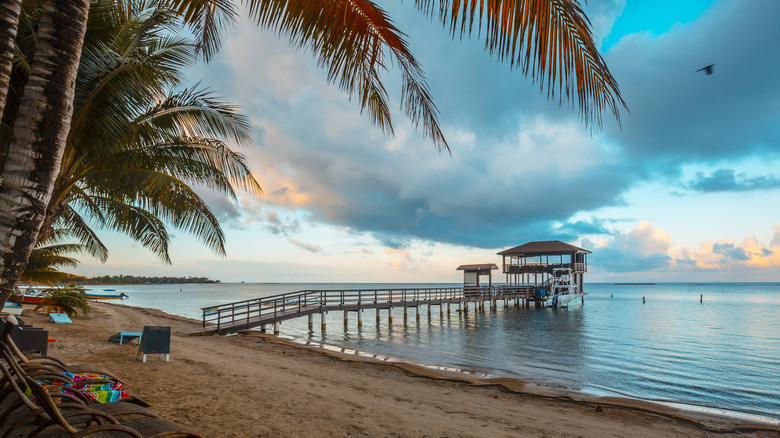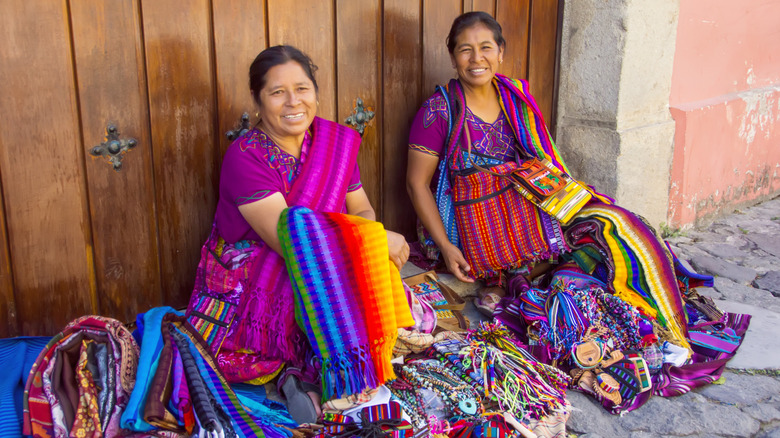The Best Cities To Retire To In Central America
There are plenty of reasons to retire to Central America. For one, there's the low cost of living; a Western pension goes a lot further in El Salvador or Guatemala than it does in the U.S. or Canada. Then there's the pleasant climate for those looking to avoid harsh winters. Furthermore, the cultural richness and history give retirees opportunities to experience diverse traditions, cuisines, and festivals, while there are also the beautiful landscapes. These include pristine beaches, striking volcanoes, dramatic mountains, and lush rainforests.
The slower pace of life and the proximity to Canada and the U.S., as well as visa and residency incentives, add to the enticing options of Central America. We've researched the area to find the best cities to retire to, taking into account factors like monthly costs, healthcare access, nearby attractions and activities, and visa requirements.
San José, Costa Rica
For retirees seeking an active urban lifestyle with access to first-class facilities and a vibrant cultural scene, the capital of Costa Rica, San José, awaits. This economic and Central American travel hub sits at 3,845 feet and enjoys a year-round pleasant climate. You could call it a mild tropical climate, with daytime highs averaging 83 degrees Fahrenheit, which only varies by as little as three degrees throughout the year. It gets pleasantly cool at night, and the seasons fall into two: the dry, which lasts from December to April, and the wet, which spans from May to November.
There's plenty for retirees to do, too. There are museums, theaters, and markets, with the best of them found at the Avenida Central pedestrian mall. This unique two-mile stretch of shopping, culture, dining, and architecture is the city's premier attraction and features parks spread out intermittently and plenty of access to public transport. Surrounding San José, you'll find an abundance of nature reserves, including the Poás Volcano and the underrated Braulio Carrillo National Park, with La Paz Waterfall Gardens another major draw for locals and foreigners alike.
But all this doesn't mean the cost of living is high. Au contraire, despite everything this city of 2.5 million people offers, it is surprisingly inexpensive to live in. Thanks to the amenities, you can live as lavish a lifestyle as you desire, but it's also possible to live comfortably on as low as $1,600 per month. Healthcare is world-class and surprisingly affordable, too, with retirees able to access the government's CAJA system and numerous private options with top specialists. And to get the benefit of all this, retirees need only show a monthly income of $1,000.
Escazú, Costa Rica
While officially a canton, Escazú is often informally referred to as a city due to its urban character and development. An upscale suburb within the San José metropolitan area, it's known as the Beverly Hills of Costa Rica and has a relatively affluent population of 45,000 and a low crime rate. With colonial architecture, art galleries, weekly farmers' markets, high-end dining, and world-class shopping at the massive Lincoln Plaza shopping mall, the city has a lot to offer retirees. On top of this, the surrounding area offers diverse activities such as hiking, birdwatching, and day trips to picturesque places like Poás Volcano and La Paz Waterfall.
Escazú sits at an elevation of 3,612 feet, and the weather is consistently comfortable throughout the year, with the warmest month, April, averaging 78.8 degrees Fahrenheit (26 degrees Celsius). However, despite carrying the Beverly Hills moniker, the cost of living for expats and retirees can be surprisingly affordable. Of course, this depends on your lifestyle and neighborhood, but average monthly costs fall between $1,500 and $2,000. This includes rent, amenities, and groceries, although the sky is the limit if you prefer a life of luxury.
Healthcare is also affordable for retirees via the public CAJA system. You must go through the residency process first, and waiting times can be longer than private care. However, both government and private facilities are renowned and modern, and doctors are internationally trained and English-speaking. CAJA care is included in Costa Rica's Pensionado Visa, a residency program specifically for retirees. With a monthly income of $1,000 from a pension or Social Security, you are entitled to a renewable residency as long as you maintain the income requirement.
Atenas, Costa Rica
Another canton with urban character popular with retirees in Costa Rica is Atenas. It's located in the Central Valley, and is known for its serene atmosphere and mild, spring-like climate. For anyone seeking a peaceful haven and a slow pace of life while maintaining easy access to amenities, this could be the place. Atenas is home to 27,000 residents, with around 1,500 foreigners making up a thriving expat community. Most of them are retirees, and they socialize together and with locals through community groups and clubs. These include meditation retreats and art groups, while the Atenas Men's Club offers regular meetings and activities to foster camaraderie among male seniors.
Retired couples can live well for $2,000 to $3,000 per month, with modern two-bedroom homes renting for around $750 to $1,100. A one-bedroom in the city center can be had for around $500, while something similar in the outskirts can cost even less. Every area in the town is regarded as safe. In fact, it's one of Costa Rica's safest, with crime rates lower than anywhere else. Even petty theft is rare, although not completely unheard of. This significantly adds to its appeal as a peaceful sanctuary for retirees.
With a lifetime retirement income of at least $1,000, foreign retirees can apply for the Pensionado Visa. This includes access to the country's affordable CAJA healthcare system. Private clinics are also available in Atenas, while specialized care is a short 30-minute drive away in San José and Escazú.
Tamarindo, Costa Rica
For a vibrant beach town with a laid-back atmosphere on the Pacific Coast, there's Tamarindo, Costa Rica. The town's moderate population of 5,000 swells to around 10,000 during the peak tourist season, and stunning beaches and the area's natural beauty are what attract retirees to the town. However, there's also a close-knit family vibe about the place, especially as the sun goes down. Children get their last giggles and games in, and dogs chase after sticks while barbecues are lit to cook the day's catch. There are also plenty of low-key beachfront bars and restaurants offering cocktails and dining, with local dishes and foreign food on the menu.
There are lots of outdoor activities for the more active retiree in Tamarindo, too. The most popular of these are confined to the ocean. Surfing is one of them. But if those days are behind you now, you can also have a go at kayaking or paddleboarding, while the nearby Las Baulas National Marine Park offers guided tours to protected areas for nesting sea turtles. You can also see these leatherbacks on snorkeling or diving trips along with rays, reef sharks, and schools of colorful fish.
This wonderful way of life doesn't even cost that much. The estimated monthly expenses for retirees lie in the $1,500 to $2,000 range. This includes everything from quality housing in gated communities to $10-per-person meals in regular eateries. For healthcare, residents with the Pensionado Visa can access Costa Rica's public healthcare system. However, there are no CAJA facilities in Tamarindo itself, so travel to nearby towns like Liberia or Nicoya is necessary. Alternatively, private clinics and hospitals in Tamarindo can offer services at higher prices.
Coronado, Panama
For another small, laid-back town known for its picturesque beaches and popular retiree activities, including golf, consider Coronado in Panama. This charming little beach town, an hour or so drive to the southwest of Panama City on the Pacific Coast, has a population of 10,000. It's a blend of locals and a well-established international community of expats and retirees. Many of the foreigners who now call Coronado home are from English-speaking countries, such as the US, Canada, and the UK, but the community integrates well with locals, and this small town has a one-big-happy-family feel to it.
Temperatures are warm year-round with distinctive wet and dry seasons, and amenities are modern and abundant. There are several well-stocked supermarkets and malls, a country club, and an assortment of leisure facilities. With Panama having one of the lowest costs of living in the world, monthly expenses are in the affordable range, at somewhere between $1,500 and $2,000. And, with a lifetime pension of $1,000 per month, retirees can enjoy the Pensionado Visa for permanent residency. This visa also offers excellent discounts throughout Coronado, including entertainment like movie theaters at half price and 25% off in many restaurants.
A one-bedroom apartment will likely be in the $500 to $700 range, and they are usually in gated communities. This is one contributing factor to the low crime rate, with Coronado generally considered a safe place. Healthcare is available locally. However, facilities may not be up to Western standards. That said, there are JCI-accredited hospitals offering specialized care and modern facilities in Panama City, just over an hour's drive away.
Boquete, Panama
If beach life isn't your thing, Boquete, Panama, offers a small, picturesque mountain town with a temperate climate in lush, green surroundings. Known as the "Valley of the Flowers and the Eternal Spring," this cool highland setting is home to more than 20,000 residents, a sizable portion of which are expats and retirees. Most of them are primarily from the US or Canada, with Brits and Europeans thrown in for good measure. All are attracted by the town's welcoming nature, affordable living, and cool weather. However, don't think that you'll only befriend foreigners. The locals are the majority in this tight-knit community, and social gatherings abound in the form of events such as the Tuesday Market and the Boquete Jazz Festival for great days out and people meeting.
The town is also a hub for outdoor enthusiasts. Hiking opportunities abound, including the Volcán Barú National Park. Climbing the volcano can take a bit of effort, but with a little preparation and reasonable fitness, the hike is accessible. Completing this challenge gives you the chance to see both the Pacific and Atlantic oceans at the same time. Boquete is also a birdwatching paradise, with colorful varieties of species to be found among the mist-enshrouded forests, while coffee plantation tours are another popular daytime activity.
Total monthly costs are estimated at $1,500 to $2,600, with a two-bedroom apartment going for as low as $650 depending on the location. For healthcare, private insurance is the recommendation. Private clinics exist in the town for basic needs, but for advanced care, you'll need to go to the nearby city of David. With the Pensionado Visa, residents can get discounts on healthcare as well as travel and entertainment.
Granada, Nicaragua
Granada sits on the shores of Lake Cocibolca, otherwise known as Lake Nicaragua, the largest body of water in Central America. It's the only freshwater lake in the world where oceanic creatures also thrive. However, the city's centerpiece is the Catedral de Granada with its distinctive yellow exterior and terracotta-colored domes. Much of the rest of this picturesque colonial city is also steeped in history, and with a population of around 150,000, it has a bustling yet uncrowded vibe. The expat community is relatively small at around 1,000 members, but they are active in groups and organizations and welcome newcomers into the fold.
While Granada enjoys year-round sunny weather, it can get hot and humid in the summer months. This leads to residents spending a lot of their time around the lake area. You can take boat rides to the tiny islets where you'll find places to eat or even stay the night if you wish. Other activities retirees can take part in include salsa dancing or yoga classes. After the sun sets, you can dine at one of the many outdoor restaurants for as little as $3 per person or sip on affordable cocktails at the famed La Calzada street. In fact, retired couples can live off as little as $1,500, while singles are probably looking at around $1,200 in monthly expenses.
The Pensionado Visa requirement is one of the lowest in the world, with applicants only needing to prove a $600 income for it to be granted. Public and private healthcare facilities are available, with basic care being more accessible and affordable, though resources may be limited and equipment old. Specialized treatments require a 45-minute drive to Managua, where you'll find the JCI-accredited Hospital Vivian Pellas.
San Juan del Sur, Nicaragua
If you prefer seashores over lakeshores, San Juan del Sur is a beautiful coastal town on the Pacific and another great option in Nicaragua. As well as a growing number of North American retirees, this small town of 20,000 residents attracts surfers and travelers attracted to its variety of surf breaks and laid-back atmosphere. In fact, the nearby town of Playas Maderas is the ideal place for surfers of all levels. So, active retirees seeking a new hobby may just have found their place.
Exploring all of the 22 stunning beaches is a wonderful way to spend your days, while there are also excellent hiking opportunities and popular classes to take, such as yoga or Spanish lessons. Horseback riding is also available, and there are plenty of opportunities for keen anglers, or you can visit La Flor Beach Natural Reserve for turtle nesting.
Meeting people to enjoy these activities with is easy. The expat scene ranges from young professionals to retirees, and the vibe is close-knit and welcoming. And it's no wonder really, when you consider it's possible to live off between $800 and $1,000 per month as a single retiree. Couples will get by on slightly less per person, and you can find a good one-bedroom apartment close to the beach for as little as $400 per month.
As with Granada, retirees can apply for the highly affordable Pensionado Visa. However, while also inexpensive, healthcare in San Juan del Sur is basic. There's a small clinic offering limited services, but for more advanced care, residents need to travel to Rivas, a 30-minute drive away. That said, for advanced healthcare at a JCI-accredited hospital, you'll need to go to Managua, which is two hours by car or taxi.
Roatán, Honduras
If you seek the island life for your retirement, Roatán, Honduras, not only offers an idyllic tropical paradise, but retirees also have access to one of the Caribbean's most affordable destinations. The city's 80,000 inhabitants include a well-established expat community, and foreigners and locals group together, and opportunities abound to meet them in the way of endless events and invitations. Volunteering is also popular among retirees, and there are a variety of ways to do it, including teaching English to kids or coaching sports. In terms of things to do, diving is a must, but it is just one way to make the most of the island.
Roatán is spread out along 48 miles, and it is just five miles wide. There are a variety of areas for retirees to settle in, including the French Harbour district in the center of the island. This place has the best infrastructure for residents with excellent grocery stores and the island's only shopping mall. It may be a bit more expensive than other Central American countries, but a couple can still live a relatively comfortable lifestyle for under $3,000 per month. Additionally, if you want the Honduran version of the Pensionado Visa, you'll need to provide proof of a lifetime income of $1,500 per month, which is more than other countries on this list.
Healthcare is another consideration. While the island does have a branch of the renowned Hospital Cemesa, which can cater to emergencies, a boat trip to the mainland is necessary for advanced care. However, for what is possibly the best weather in the Caribbean (including a lack of hurricanes), world-class scuba diving, and some of the best sports fishing you can find, retirement in Roatán is well worth your consideration.
Antigua, Guatemala
The small city of Antigua is one of the most highly-rated destinations in Central America. It's located at an elevation of 1,500 feet in the Central Highlands of Guatemala, is the ideal spot for retirees who prefer a relaxed lifestyle infused with culture and natural beauty. With oodles of colonial charm mixed with modern facilities, warm year-round weather, and a friendly-yet-thriving international expat community, adventurous retirees are in danger of falling in love with the city and never returning home.
With a population of around 60,000, Antigua isn't that big. Crime is low, and the charming streets steeped in history with their timeless architecture are highly walkable. The weather rarely gets too hot, comfortably staying under 86 degrees Fahrenheit (30 degrees Celsius) throughout the year, although it does experience a bit of wet weather during the distinct rainy season. Between the months of May and October, sunshine hours can be interrupted with brief showers, so you can expect to have to carry an umbrella on afternoon strolls. The city also offers retirees a bounty of activities from art galleries and festivals to volcano hiking, birdwatching, and nature trails in the lush, rolling landscapes of the highland surroundings.
Monthly costs can be as low as $1,000, including rent. Dining out is affordable, and options range from street food to upscale international restaurants. Healthcare is inexpensive, too, with private insurance in Guatemala typically costing less than $100 per month. However, facilities in Antigua are pretty basic, and for advanced medical care, patients must go to Guatemala City, about a 40-minute drive away. For the Guatemalan version of the Pensionado Visa, retirees need to provide proof of a $1,000 income and a clean criminal record.
